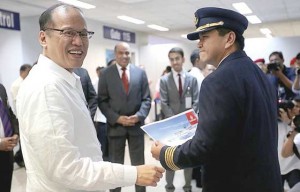THE world’s biggest airliner landed at the Ninoy Aquino International Airport (NAIA) on Tuesday night piloted by a Filipino.
Emirates Airlines’ Airbus A380 touched down at 10:10 p.m. after flying non-stop from the Dubai International Airport for about 12 hours.
President Benigno Aquino 3rd led welcome ceremonies at NAIA’s Terminal 3 for the flight’s 300 passengers and its crew of 24 led by Capt. Franklyn Mallari Desiderio.
After taxiing at the runway, the plane was given a water-cannon salute.
The A380 is a double-deck, four-engine jet airliner with a 525-seat capacity expandable to 853 in an all-economy class configuration.
Desiderio said he trained for more than three months beginning in January before he took command of an A380.
He added that basic training took about 25 days and was extended for more than two months for some adjustments “because the standard of Emirates is quite high and you have to surpass even the bottom level of the standard.”
The 41-year-old from Bulacan was a pilot for Philippine Airlines before he transferred to Emirates. He started as first officer and co-pilot in the airlines’ A330 fleet before moving up to piloting A340s.
He has been flying airliners for 18 years, and his advice to young pilots is to just keep on studying “what they have learned in school and bring it up in the future, while building their career.”
Desiderio described the A380 as “a gentle giant once you get off the ground. It flies so smooth, really gentle, because of the huge wings, the design, and the powerful engines.”
He said the NAIA “is capable of accepting this A380 any time. Maybe they will put some limitations between traffic on taxiing but operations-wise, I think it is feasible.”
Desiderio described the landing “as really nice. We turned near the end of the runway, the Echo 5. There are some restrictions on taxiing because we cannot taxi and allow others to land at the same time. But I think if they put some more time on these limits and other considerations, I think we can match it up.”
In a written statement, Emirates’ Divisional Senior Vice President Barry Brown said, “Bringing our flagship A380 to Manila is a fantastic way to celebrate our move to the new international terminal and also our commitment to the Philippines.”
He thanked the Philippine government for allowing the airlines to operate three daily flights to Manila. “The Philippines is one of our major markets and we have seen the demand for our services continuing to grow,” Brown said.
He added that since Emirates opened its Manila-to-Dubai route 24 years ago, it has served over 6.6 million passengers and carried over 150,000 tons of cargo.
While at Terminal 3 the President took the time to inspect its facilities including X-ray machines, check-in counters, terminal fee windows and pre-departure areas.
Five foreign airlines—Emirates, Delta, KLM Royal Dutch, Singapore and Cathay Pacific—have completed transferring from NAIA Terminal 1 to Terminal 3.
The five airlines are expected to bring in 3.5 million more passengers to Terminal 3 every year, which is roughly a third of the terminal’s capacity of 13 million international passengers a year.
NAIA 3 resumed full operations on July 31 after a P1.9-billion renovation.
WITH A REPORT FROM CATHERINE S. VALENTE


